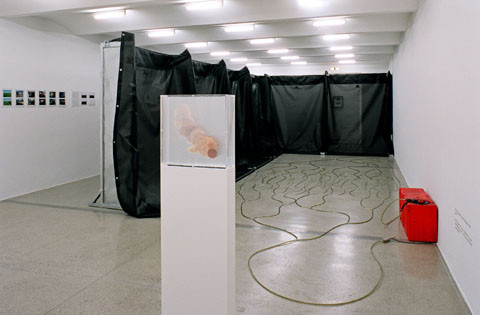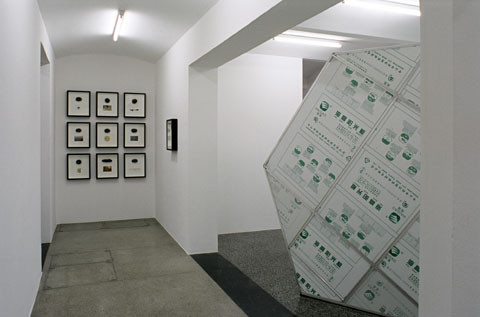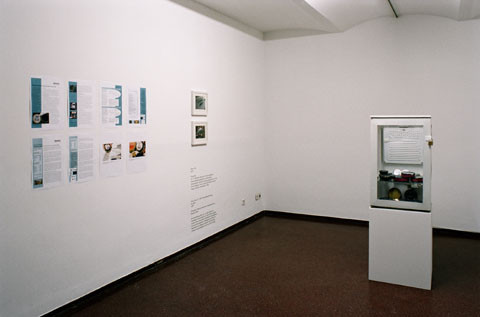Tue Greenfort
20 Sep - 18 Nov 2007
TUE GREENFORT
MEDUSA
September 20 – November 18, 2007
How do we define our role in the world? This is the question asked by Danish artist Tue Greenfort, who sees humanity as a marginal part of a far greater whole and who identifies a close link between the question of progress—be it technical, cultural or interpersonal—and our ability to rethink our position in the world. Greenfort’s works reflect his interest in issues of ecology and economics: thinking in global terms, he examines our approach to environmental protection and biodiversity, to resources and sustainable development in view of dwindling supplies of certain materials, relating these themes to the system of art.
Tue Greenfort’s projects are characterized by interdisciplinary openness and a “scientific” approach based on extensive research. MEDUSA, the artist’s first major solo exhibition in Austria, focuses on the complex links between monoculturalization and its consequences, such as the loss of diversity and habitats, both in nature and in urban public space. The show occupies spaces throughout the Secession building, including some not usually used for exhibitions.
Betting up a caviar bar in the former café of the Secession, Greenfort focuses attention on the links between the caviar trade—an extremely lucrative business, with a kilogram of beluga caviar costing up to 7000 euro—and the threat of extinction to the beluga sturgeon (Huso huso), one of the Earth’s oldest species. In spite of a UN convention protecting it, poaching seems to be beyond any form of control. Greenfort relates this development to a notion of luxury and wealth, and to cultural production, the idea of art as a luxury and market value as opposed to autonomous artistic work. In cooperation with WWF Austria and the Austrian Finance Ministry, the artist was able to obtain caviar confiscated by the customs authorities, which he presents as a readymade. This precious commodity is displayed embedded in a narrative of the history of preindustrial sturgeon fishing using historical photographs.
In another project developed specially for the Secession in cooperation with Vienna Butterfly House, Greenfort focuses on the threat posed to biodiversity by structural changes to habitats in the spread and intensification of monocultures. In each of a series of brief interventions by performer Mia Parmas, visitors to the exhibition will be shown a living specimen of an exotic species of butterfly that is threatened with extinction and which is therefore being bred at the Butterfly House. The exclusivity of the exotic species is contrasted—also in terms of its unspectacular appearance—with the common European cabbage white that is able to adapt perfectly to monocultures and thus to today’s living conditions. This species is presented in the form of a specimen prepared by the artist in the style of traditional natural history collections. Thus the usual scale of values is inverted, using this moment of fleetingness to call into question both artistic forms of representation and the values of collectors.
TUE GREENFORT, born in 1973 in Holbæk (Denmark), lives and works in Berlin.
SOLO SHOWS (selection): 2007 Johann König, Berlin; 2006 Max Wigram Gallery, London; Arts & Ecology programme, Royal Society of Arts, London; 2005 Betreten des Grundstücks erlaubt, Kunstverein Arnsberg; Als ob wir nicht die Besitzende wären, Palais für Aktuelle Kunst, Gluckstadt; Dänische Schweine und andere Märkte, Johann König, Berlin; 2004 Umwelt, Gallery Zero, Milan; RE PRÄSENTATION, 1822 Forum, Frankfurt am Main; Spediteur Zimmer, Galerie Nicolas Krupp, Basel; 2003 Used and Produced, Schnittraum, Köln; Fresh and Upcoming, Frankfurter Kunstverein; 2002 Out of site, Johann König, Berlin; 2001 The Peripheral Centre, Dontmiss, Frankfurt/Main; 2000 Exchange, in cooperation with NIFCA, Städelschule, Frankfurt/Main.
GROUP SHOWS (selection): 2007 RSA, Royal Society for Encouragement of Arts, London; Made in Germany, Sprengel Museum Hannover; Modelle von morgen: Köln, Europäische Kunsthalle, Cologne; OEen Group Show, OEen Group, Copenhagen; Skulptur Projekte Münster; Nachvollziehungsangebote, Kunsthalle Exnergasse, Vienna; 2006 Momentum, Nordic Festival of contemporary art, Moss; Jagdsalon, Kunstraum Kreuzberg, Berlin; Inaugural Exhibition, Johann König, Berlin; 2005 Lichtkunst aus Kunstlicht, ZKM, Karlsruhe; Threshold, Max Wigram Gallery, London; 2004 L ́attitude des autres, SMP, Marseilles; Ce qui reste, Galerie du TNB, Rennes, Prisma, Galerie Martin Janda, Vienna.
We wish to thank the following for their help with developing and realizing the projects: Stephen Fried of Vienna Butterfly House; Christian Kubicek, Institute of Chemical Engineering, Vienna Technical University; Jutta Jahrl, WWF Austria; Austrian Finance Ministry; Vienna Natural History Museum.
For further information please contact:
Urte Schmitt-Ulms, tel.: +43 1 587 53 07-10;
fax: +43 1 587 53 07-34; email: pr@secession.at
MEDUSA
September 20 – November 18, 2007
How do we define our role in the world? This is the question asked by Danish artist Tue Greenfort, who sees humanity as a marginal part of a far greater whole and who identifies a close link between the question of progress—be it technical, cultural or interpersonal—and our ability to rethink our position in the world. Greenfort’s works reflect his interest in issues of ecology and economics: thinking in global terms, he examines our approach to environmental protection and biodiversity, to resources and sustainable development in view of dwindling supplies of certain materials, relating these themes to the system of art.
Tue Greenfort’s projects are characterized by interdisciplinary openness and a “scientific” approach based on extensive research. MEDUSA, the artist’s first major solo exhibition in Austria, focuses on the complex links between monoculturalization and its consequences, such as the loss of diversity and habitats, both in nature and in urban public space. The show occupies spaces throughout the Secession building, including some not usually used for exhibitions.
Betting up a caviar bar in the former café of the Secession, Greenfort focuses attention on the links between the caviar trade—an extremely lucrative business, with a kilogram of beluga caviar costing up to 7000 euro—and the threat of extinction to the beluga sturgeon (Huso huso), one of the Earth’s oldest species. In spite of a UN convention protecting it, poaching seems to be beyond any form of control. Greenfort relates this development to a notion of luxury and wealth, and to cultural production, the idea of art as a luxury and market value as opposed to autonomous artistic work. In cooperation with WWF Austria and the Austrian Finance Ministry, the artist was able to obtain caviar confiscated by the customs authorities, which he presents as a readymade. This precious commodity is displayed embedded in a narrative of the history of preindustrial sturgeon fishing using historical photographs.
In another project developed specially for the Secession in cooperation with Vienna Butterfly House, Greenfort focuses on the threat posed to biodiversity by structural changes to habitats in the spread and intensification of monocultures. In each of a series of brief interventions by performer Mia Parmas, visitors to the exhibition will be shown a living specimen of an exotic species of butterfly that is threatened with extinction and which is therefore being bred at the Butterfly House. The exclusivity of the exotic species is contrasted—also in terms of its unspectacular appearance—with the common European cabbage white that is able to adapt perfectly to monocultures and thus to today’s living conditions. This species is presented in the form of a specimen prepared by the artist in the style of traditional natural history collections. Thus the usual scale of values is inverted, using this moment of fleetingness to call into question both artistic forms of representation and the values of collectors.
TUE GREENFORT, born in 1973 in Holbæk (Denmark), lives and works in Berlin.
SOLO SHOWS (selection): 2007 Johann König, Berlin; 2006 Max Wigram Gallery, London; Arts & Ecology programme, Royal Society of Arts, London; 2005 Betreten des Grundstücks erlaubt, Kunstverein Arnsberg; Als ob wir nicht die Besitzende wären, Palais für Aktuelle Kunst, Gluckstadt; Dänische Schweine und andere Märkte, Johann König, Berlin; 2004 Umwelt, Gallery Zero, Milan; RE PRÄSENTATION, 1822 Forum, Frankfurt am Main; Spediteur Zimmer, Galerie Nicolas Krupp, Basel; 2003 Used and Produced, Schnittraum, Köln; Fresh and Upcoming, Frankfurter Kunstverein; 2002 Out of site, Johann König, Berlin; 2001 The Peripheral Centre, Dontmiss, Frankfurt/Main; 2000 Exchange, in cooperation with NIFCA, Städelschule, Frankfurt/Main.
GROUP SHOWS (selection): 2007 RSA, Royal Society for Encouragement of Arts, London; Made in Germany, Sprengel Museum Hannover; Modelle von morgen: Köln, Europäische Kunsthalle, Cologne; OEen Group Show, OEen Group, Copenhagen; Skulptur Projekte Münster; Nachvollziehungsangebote, Kunsthalle Exnergasse, Vienna; 2006 Momentum, Nordic Festival of contemporary art, Moss; Jagdsalon, Kunstraum Kreuzberg, Berlin; Inaugural Exhibition, Johann König, Berlin; 2005 Lichtkunst aus Kunstlicht, ZKM, Karlsruhe; Threshold, Max Wigram Gallery, London; 2004 L ́attitude des autres, SMP, Marseilles; Ce qui reste, Galerie du TNB, Rennes, Prisma, Galerie Martin Janda, Vienna.
We wish to thank the following for their help with developing and realizing the projects: Stephen Fried of Vienna Butterfly House; Christian Kubicek, Institute of Chemical Engineering, Vienna Technical University; Jutta Jahrl, WWF Austria; Austrian Finance Ministry; Vienna Natural History Museum.
For further information please contact:
Urte Schmitt-Ulms, tel.: +43 1 587 53 07-10;
fax: +43 1 587 53 07-34; email: pr@secession.at



